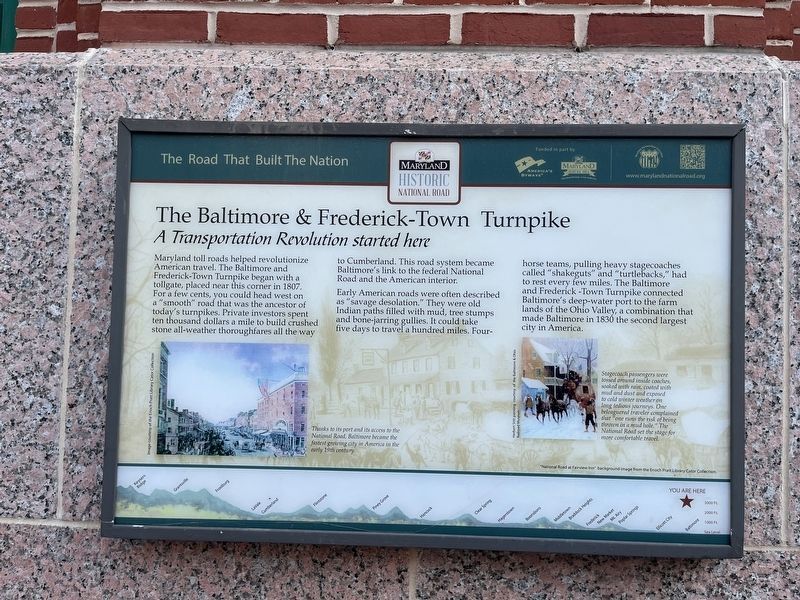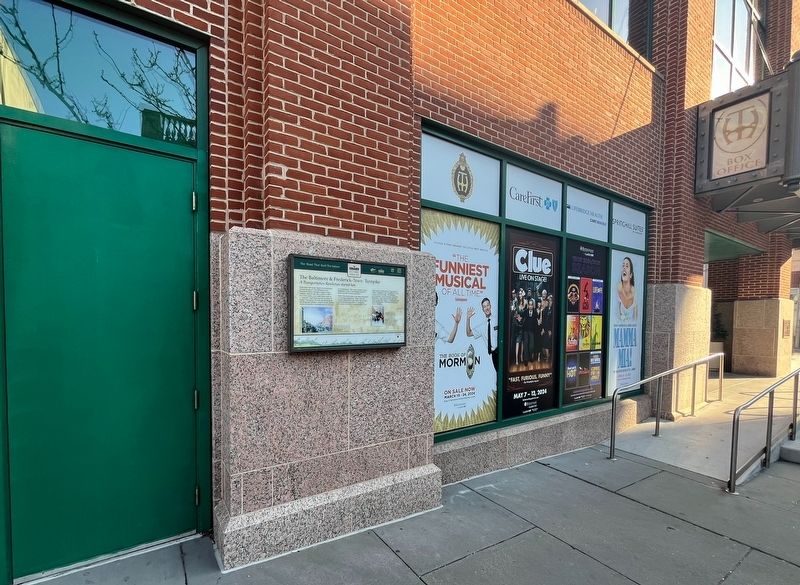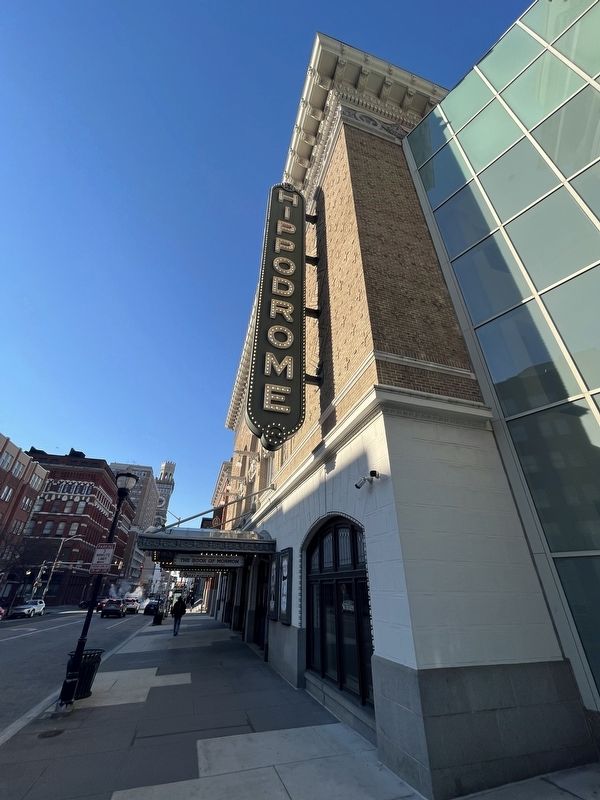Bromo Arts District in Baltimore, Maryland — The American Northeast (Mid-Atlantic)
The Baltimore & Frederick-Town Turnpike
A Transportation Revolution started here
— The Road That Built The Nation —

Photographed By Devry Becker Jones (CC0), March 22, 2024
1. The Baltimore & Frederick-Town Turnpike Marker
Maryland toll roads helped revolutionize American travel. The Baltimore and Frederick-Town Turnpike began with a tollgate, placed near this corner in 1807. For a few cents, you could head west on a "smooth" road that was the ancestor of today's turnpikes. Private investors spent ten thousand dollars a mile to build crushed stone all-weather thoroughfares all the way to Cumberland. This road system became Baltimore's link to the federal National Road and the American interior.
Early American roads were often described as "savage desolation." They were old Indian paths filled with mud, tree stumps and bone-jarring gullies. It could take five days to travel a hundred miles. Four-horse teams, pulling heavy stagecoaches called "shakeguts" and turtlebacks," had to rest every few miles. The Baltimore and Frederick-Town Turnpike connected Baltimore's deep-water port to the farm lands of the Ohio Valley, a combination that made Baltimore in 1830 the second largest city in America.
[Captions:]
Thanks to its port and its access to the National Road, Baltimore became the fastest growing city in America in the early 19th century.
Stagecoach passengers were tossed around inside coaches, soaked with rain, coated with mud and dust and exposed to cold winter weather on long tedious journeys. One beleaguered traveler complained that "one runs the risk of being thrown in a mud hole." The National Road set the stage for more comfortable travel.
Erected by America's Byways; Maryland Heritage Areas Authority; Maryland National Road Association.
Topics and series. This historical marker is listed in these topic lists: Industry & Commerce • Roads & Vehicles. In addition, it is included in the The Historic National Road series list. A significant historical year for this entry is 1807.
Location. 39° 17.363′ N, 76° 37.274′ W. Marker is in Baltimore, Maryland. It is in the Bromo Arts District. Marker is on West Baltimore Street west of North Eutaw Street, on the left when traveling east. The marker is affixed to the outside of the Hippodrome Theatre at the France-Merrick Performing Arts Center. Touch for map. Marker is at or near this postal address: 420 W Baltimore St, Baltimore MD 21201, United States of America. Touch for directions.
Other nearby markers. At least 8 other markers are within walking distance of this marker. The Classic Building (about 300 feet away, measured in a direct line); Baltimore Equitable Society (about 300 feet away); Faust Brothers Building (about 400 feet away); Original Burial Place of Edgar Allan Poe (about 600 feet away); Among Family: Poe’s Original Burial Place (about 600 feet away); A Beloved General

Photographed By Devry Becker Jones (CC0), March 22, 2024
2. The Baltimore & Frederick-Town Turnpike Marker
Related marker. Click here for another marker that is related to this marker. This marker has replaced the linked marker.

Photographed By Devry Becker Jones (CC0), March 22, 2024
3. Hippodrome Theatre at the France-Merrick Performing Arts Center
The Hippodrome is a historic location in its own right. It was hosting vaudeville performances in the 1930s as well as historic film premiers prior to its shuttering in 1990. It is also featured prominently in the opening credits to John Waters' 2000 film, Cecil B. Demented, along with other historic cinemas in Baltimore City.
Credits. This page was last revised on March 23, 2024. It was originally submitted on March 23, 2024, by Devry Becker Jones of Washington, District of Columbia. This page has been viewed 95 times since then. Photos: 1, 2, 3. submitted on March 23, 2024, by Devry Becker Jones of Washington, District of Columbia.